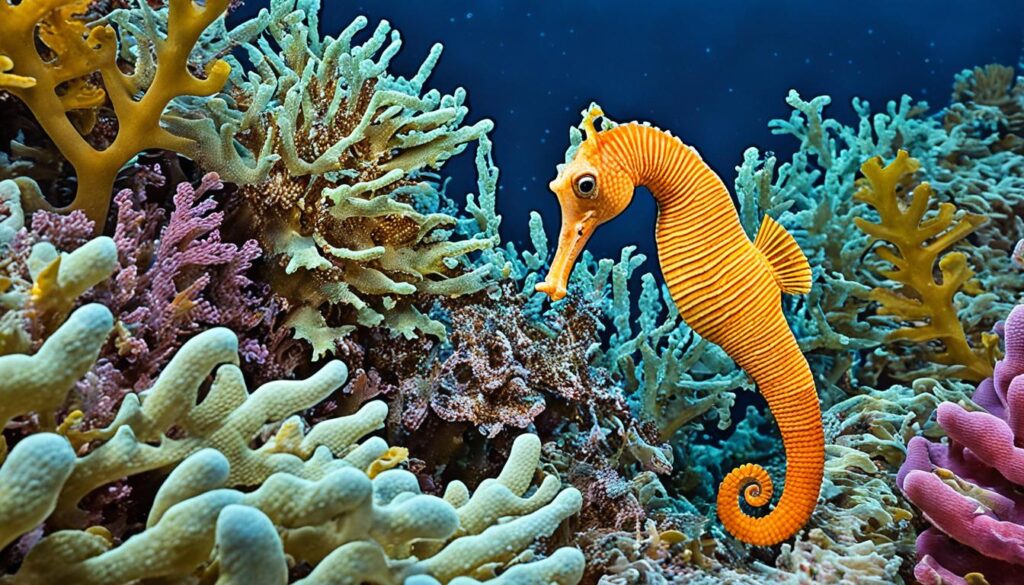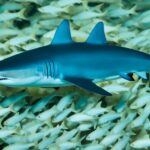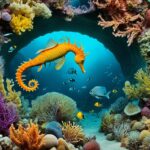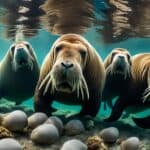Understanding how long seahorses live is crucial. You might ask, how long do seahorses live? Their lifespan varies greatly by species. Smaller ones usually live about a year, while bigger ones can live 8 to 10 years in good captivity.
This knowledge helps us appreciate these marine animals more. It also highlights the need to protect their homes. Human actions are putting their habitats at risk.
Introduction to Seahorses and Their Lifespan
Seahorses are fascinating marine creatures known for their horse-like heads and curled tails. They belong to the family Syngnathidae, which also includes pipefish and other related species. When we talk about introduction to seahorses, we must mention their unique traits, where they live, and how they reproduce. These fish live in shallow coastal waters, hiding in seagrasses, mangroves, and coral reefs.
The lifespan of seahorses varies greatly depending on their environment and type. Factors like water quality, food, and predators affect their seahorse longevity. Their unique way of reproducing, where males carry young in pouches, also plays a role in their survival and seahorse life expectancy.
It’s vital to understand the challenges seahorses face in the wild. Threats like overfishing and habitat destruction affect their survival. By learning more about their lifespan, we can see how to protect these amazing creatures in our oceans.
Understanding Seahorse Lifespan
Learning about seahorse lifespan is more than just knowing how long they live. It involves looking at their natural behaviors, how they reproduce, and the challenges they face in their environment. Different seahorse species live longer or shorter lives, which affects their numbers and how they interact with their surroundings.
When we talk about how long seahorses live, we look at both the wild and those in captivity. Scientists study captive seahorses to learn about their lifespan. This helps us improve how we breed and protect them. But, finding information about wild seahorses is harder, making research a challenge.
Understanding what affects seahorse longevity shows us how important their environment is. Things like destroying their homes, pollution, and climate change can hurt their chances of survival. Knowing about seahorse lifespan helps us understand their behavior and how they live.
| Factor | Impact on Lifespan |
|---|---|
| Habitat Quality | High-quality habitats lead to a longer lifespan. |
| Pollution Levels | Increased pollution can shorten lifespan. |
| Predation | Higher predation risk correlates with reduced longevity. |
| Reproductive Strategies | Species with unique reproductive traits often show varied lifespan outcomes. |
Looking into these factors helps us understand the complex world of seahorse lifespan. By exploring these influences, we see the fine balance that keeps their populations stable in the wild and captivity.
How long do seahorses live?
Seahorses live different lengths of time, sparking curiosity about their lifespan. Knowing how long they live helps us understand their survival in various places.
General Lifespan Estimates
Seahorses come in all sizes, and their lifespans vary. Smaller ones might live only a year, while bigger ones can live much longer. In the wild, big seahorses usually live three to five years. But in captivity, they can live up to ten years. This shows how important their living conditions are for their life span.
Variability Between Species
Each seahorse species lives differently, making it hard to give a simple answer to how long they live. This means conservation efforts need to be tailored to each species. By understanding each species’ unique traits, we can protect their homes better and help them survive. Knowing how long seahorses live helps us make better conservation plans.
Factors Affecting Seahorse Longevity
Many things affect how long seahorses live. Knowing what these are can help us understand their survival and how they reproduce. We look at their living space, the dangers they face, and how humans affect them. This helps us see how these things work together to decide how long they live.
Habitat Conditions
The place where seahorses live greatly affects their life span. They need clean water, lots of food, and the right temperature to do well. If their homes are dirty or polluted, seahorses get stressed, which can shorten their lives.
Predation Risks
Seahorses have many predators, like big fish and birds. These dangers can make their numbers go down and shorten their lives. To survive, they must be good at hiding and finding safe places.
Human Impact
Humans have a big effect on seahorses. Things like overfishing, pollution, and destroying their homes harm them. We need to use the earth wisely and protect these creatures to help them live longer.
The Differences in Lifespan Among Species
Seahorses have different lifespans, mainly because of their size and how they adapt to their environment. Knowing these differences is key to saving both small and large seahorse species.
Small Seahorse Species
Small seahorses, like Hippocampus zosterae, live about a year. They grow fast but are also easily affected by their environment. This makes their lives short.
Larger Seahorse Species
Larger seahorses, such as the Australian big-bellied seahorse, can live three to five years or more. Being bigger helps them survive better and breed more successfully. This shows why we need to protect each seahorse type differently.
Seahorse Aging: Insights and Research
Research is uncovering new insights into how seahorses age. To grasp seahorse aging, we must look at both their biology and their environment. Studies show that seahorses in captivity live longer than those in the wild.
Environmental factors greatly impact seahorse aging. Things like food, habitat, and predators affect their lifespan. By exploring this, we learn more about how seahorses age.
Studies are still ongoing to understand seahorse aging better. They help us learn how to protect these creatures. This research is crucial for saving their homes and understanding their lives.

Impacts of Captivity on Seahorse Life Expectancy
Captivity has a big impact on seahorses’ lives. In an aquarium, you can give them the best conditions to live longer than in the wild. But, you need to know what these creatures need to avoid shortening their lives.
Care and Environment in Aquariums
Looking after seahorses in tanks involves many things. The tank’s size, water quality, and food are key to their health. A good aquarium that feels like their natural home helps with better water and food, which can make them live longer.
But, ignoring these things can make them stressed and sick, cutting their lives short. Also, how they get along with other fish in the tank matters. Making sure they have a good group can help them live longer and avoid problems.
Knowing these details is important for people who keep seahorses. It helps them support these creatures’ long lives and helps with breeding and saving them.










